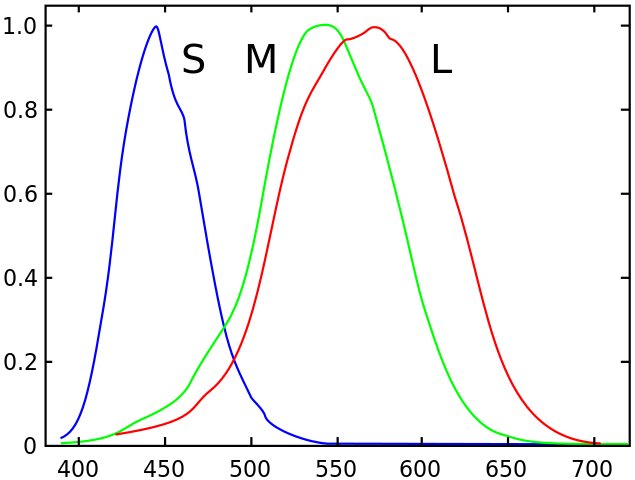Science
Related: About this forumColor vision and X-inactivation.
Normal color vision in humans is said to be trichromatic, since there are normally three types of cones in our retinas. The most common types of color deficiencies result from abnormal or missing genes on our X chromosomes. Most of the readers in the Science Group have probably heard that many men, but few women, are "red-green colorblind". This trait is said to be sex-linked and recessive, like baldness and many other abnormalities that affect more men than women.
Roughly speaking, if a man has such a trait and a woman is not a carrier for that trait, their children will not have the trait, but half of their daughters will be carriers. If a woman is a carrier and a man does not have the trait, half of their sons will have the trait, and half of their daughters will be carriers. If a woman is a carrier and a man has the trait, then half of their children of either sex will have the trait, and the daughters who don't have the trait will be carriers. These statements follow from the facts that every female cell has two X chromosomes and every male cell has only one X chromosome.
But the real situation is more complicated. In very precise color-matching experiments, women who are normally considered to be carriers have been shown to have a slight deficit compared to women who are not carriers. In other words, the genes for color deficiencies are not completely recessive. This has to do with the fact that one of the X chromosomes in each cell of a woman's body is inactivated, i.e., most of its genes are not expressed. The reason for X inactivation is to prevent a mismatch between males and females in the amounts of messenger RNA (and hence the amounts of protein) that are produced. In animals (but not plants) if the level of gene expression is off by a factor of two, the results are usually deleterious and often fatal. Even if the level is only off by 50%, as in trisomy 21 (Down Syndrome), there are serious consequences.
A female "carrier" of a sex-linked trait will have clumps of cells in which the X chromosome inherited from her father is inactivated, and other clumps in which the X chromosome inherited from her mother is inactivated. The patches of fur in a calico cat are similarly explained. The retina in each eye will have abnormal patches and normal patches. It's not surprising that such an eye does not perform quite as well as a completely normal eye.
CaliforniaPeggy
(149,748 posts)I am such a carrier. My father was red/green colorblind and my mom had normal vision. So one of my x chromosomes is from each parent, and the one from my dad is abnormal.
I've never had a problem with my red/green vision, thank goodness. Perhaps some sophisticated testing would show otherwise.
![]()
![]()
Lionel Mandrake
(4,076 posts)There are several types of red-green colorblindness. Since your father was unaware of it until he was tested as an adult, I'm guessing he had one of the innocuous types: either protanomaly or deuteranomaly. For definitions of these terms, see
https://en.wikipedia.org/wiki/Color_blindness
BlueJazz
(25,348 posts)Thanx for posting. ![]()
Lionel Mandrake
(4,076 posts)Here is a reference:
http://www.ncbi.nlm.nih.gov/pubmed/22333238
BlueJazz
(25,348 posts)Ah..I see. I especially liked the last part.
The increased sensitivity of PA carriers at lower light levels is consistent with the pooling of signals from the hybrid M' and the M cones and the subsequent stronger inhibition of the rods. The findings suggest that signals from hybrid photopigments may pool
preferentially with the spectrally closest "normal" pigments.
This isn't specifically my field but as an amateur astronomy (and a serious one) This explains a lot. ![]()
Lionel Mandrake
(4,076 posts)I'm glad you found it interesting. It's not my field, either, but I find the whole topic of color vision fascinating.
I assume you as an amateur astronomer use a red flashlight when you want to keep your night vision. This works if the red light doesn't leak into the part of the visible spectrum where the rods operate.
BlueJazz
(25,348 posts)...destroy Rhodopsin (almost forgot the chemical). At least that's what the manufacturer says.
"Aww..put 2 more red things on the light and charge them 35 bucks more" ![]()
Been thinking of getting this > http://www.daystarfilters.com/Quark.shtml
so a person can see the sun like this > http://www.hydrogenalpha.com/
Lionel Mandrake
(4,076 posts)Last edited Sat Aug 1, 2015, 08:59 PM - Edit history (1)
Anyone who tries to read the scientific literature on colorblindness will encounter a bizarre terminology for different types of colorblindness. Most of the bizarre terms fit into a neat pattern, as shown in the following table:
...................................................................................Anomalous
Cone ........................ Generic ........... Dichromacy ........ Trichromacy
Type ......................... Terms ....................................... (Anomalous
....................................................... (Dichromat) ..........Trichromat
....................................................................................or Anomal)
Red .............................. ? ................. Protanopia ......... Protanomaly
(L)
............................... Protan ............. (Protanope) ......... Protanomal
Green ........................... ? .............. Deuteranopia ......... Deuteranomaly
(M)
............................... Deutan ........... (Deuteranope) ....... Deuteranomal
Blue ............................ ? .................. Tritanopia .......... Tritanomaly
(S)
................................ Tritan .............. (Tritanope) ......... Tritanomal
The table requires some explanation.
The three types of cones are sometimes called red, green, and blue, but more often they are called L, M, and S, which stand for long, medium, and short (wavelength), respectively.
The table shows words for various types of deficiency (e.g., tritanopia) and words for people who have deficiencies (e.g., tritanope). A question mark indicates that I am not aware of any word that fits in a particular spot in the table. For example, AFAIK there is no word for the deficiency that a protan has.
The generic terms include dichromats and anomalous trichromats. Thus a protan has either protanopia or protanomaly, a deutan has either deuiteranopia or deuiteranomaly, and a tritan has either tritanopia or tritanomaly.
The words protanomal, deuteranomal, tritanomal, and anomal, which I added to this table on the first edit, are exceedingly rare.
hunter
(38,339 posts)Our little nocturnal furry mammal ancestors lost the excellent color vision many birds and reptiles still enjoy.
"Trichromacy" in the Superfamily Hominoidea is a wretched evolutionary kludge. It helps me to think of it as "sort-of-good-enough trichromacy."
Further complicating the story, it's recently been discovered that some of the color sorting is done in a structural way, by the shape of optical fibers leading to the light sensitive cells...

Red and green light are funnelled through the (Muller glia) cells, while blue scatters much more
http://www.bbc.com/news/science-environment-31775458
A great deal of color sorting is also done in "software," which means our perception of color isn't at all precise, just a rough guess based on experience and, to put it again in computer terms, some very extreme post-processing which introduces a lot of artifacts into the image we perceive.
The human eye is remarkable in many ways, but it is a terrible camera. What we "see" is a heavily enhanced and "photoshopped" version of the actual reality.
Lionel Mandrake
(4,076 posts)Once upon a time some monkeys from Africa took a ride on a raft and landed in South America, which had long been separated from other continents. Like most contemporary mammals (including all other monkeys), these original New World monkeys were dichromats. They evolved into all of today's New World monkeys.
Meanwhile back in the Old World, a couple of mutations took place: the gene for long wavelength cones on the X chromosome was duplicated, and the daughter genes became differentiated, so that one of them became an L gene and the other became an M gene. Thus was born the first instance of trichromacy in our ancestors.
Since one gene was almost a copy of anther gene right next to it, errors during crossing over led to various numbers of almost-copies of the original gene. The first two such genes on an X chromosome code for the opsins in L and M cones. Other almost-copies are not expressed. Both L and M genes have many polymorphisms, which give rise to the most common color deficiencies (tabulated in the OP).
Meanwhile back in the New World, similar kludges arose independently in several groups of monkeys. Howler monkeys, for example, are trichromats like us. Some New World monkeys are dichromats, and some groups have trichromacy only in females (which is probably good enough, since a female trichromat can show other members of her clan where the best food is).
As kludged up as it is, our form of trichromacy must have given our ancestors a big advantage, since dichromacy has died out among Old World monkeys.
Here's a scholarly article about Müller cells:
http://www.ncbi.nlm.nih.gov/pmc/articles/PMC1895942/
hunter
(38,339 posts)
The four pigments in estrildid finches' cones extend the range of colour vision into the ultraviolet
https://en.wikipedia.org/wiki/Tetrachromacy
Notice how neatly spaced the sensitivities are.
Humans:

https://en.wikipedia.org/wiki/Trichromacy
You can see the kludge.
I've never met a parrot who was terribly impressed by television, maybe because to a parrot the colors reproduced make people look like cold corpses living in a world made of mud under a smoggy sky..
One advantage we apes evolved was telling when the fruit was ripe.
Many plants evolved to favor birds over mammals in fruiting because seeds are carried further, and are more likely to pass through birds without being chewed up and digested. One way for plants to favor birds is to use color signals most mammals can't see. Another way is like hot peppers do with Capsaicin. Birds don't mind hot peppers at all, mammals are repelled, well, humans are weird.
Worst pepper burn I ever got was from our parrot who had been happily munching very hot peppers when she flew over, landed on my shoulder, and decided one of my eyelashes was out of place...AAAAAAGGGGGHHHHHH! My eye was on fire!
Lionel Mandrake
(4,076 posts)1. The curves for birds and humans show different types of data. The curves for birds show the spectral absorptions of different types of cones, whereas the curves for mammals are the effective spectral absorptions taking into account absorption by other structures in the eye. The most important other structure is the lens, which effectively cuts off ultraviolet light before it can reach the retina. That's why the curves for humans go to zero at very short wavelengths.
2. The peaks of the curves for the L and M cones in humans vary quite a bit among individuals, because of the many polymorphisms in the genes that control the pigments in these cones. Evolution has moved these two peaks as far apart as possible in the most fit individuals. Mildly deleterious alleles have the effect of moving the L and M peaks closer together. If L peak is normal and the M peak is abnormal, the individual has deuteranomaly. If M peak is normal and the L peak is abnormal, the individual has protanomaly. (There is no name for the type of deficit in which both peaks are abnormal.)
Lionel Mandrake
(4,076 posts)to include some color-deficit terms I just found out about.